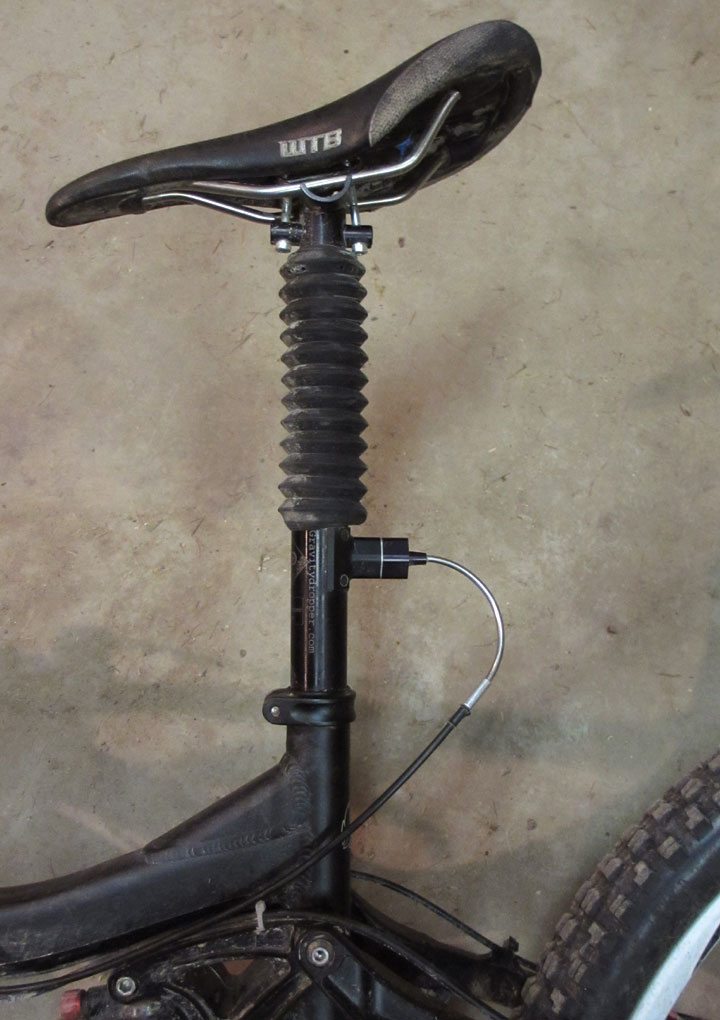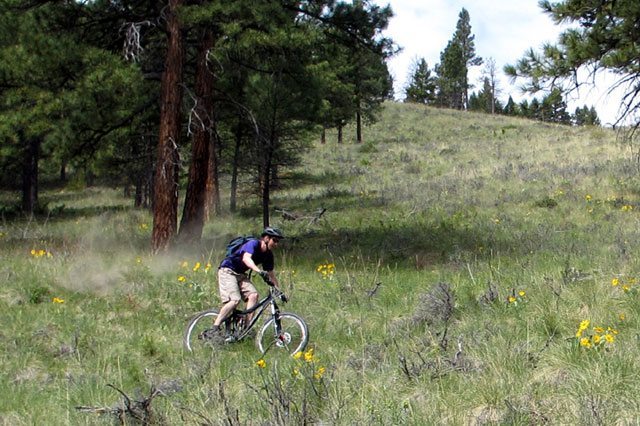
The next big plus of the Turbo over many of the other posts on the market is the cable mounting position. On the Turbo, the cable entry is fixed at a location on the lower/outer post, with the cable entering perpendicularly. This means that the cable does not move as the post is raised and lowered, a significant benefit that makes cable routing easier and helps keep the cable from getting mangled in suspension linkage. The cable entry point adds about 40mm of height, which means the seat can’t go quite as low as some other posts, but I never found this to be a problem.
Another benefit of the cable mounting position is that, because there isn’t any cable at the seatpost head to get in the way of the seapost mount, the GravityDroppers can use a proper two-bolt mount, similar to that found on a Thomson seatpost. The head is also symmetrical, meaning it is reversible. This means the post can be flipped 180 degrees, allowing the cable to enter either in the front or the back of the post.
While I prefer orienting the post with the cable entering from the rear (I think it’s a bit cleaner), some frames, especially longer-travel ones, may necessitate flipping the post around so that the cable comes out the front, as the perpendicular entry point leaves a large piece of cable directly in the path of the rear wheel. Rather than flip the post, I opted to use an old V-brake noodle, which removed the large loop of cable and made the cable routing relatively clean. Though even with this addition, I still buzzed the noodle on my tire in hard bottom-outs.
The fourth big selling point, that GravityDropper makes their products here in America, means that should you need support for the post, it’s readily available. Not only that, but you can buy any part of the post directly from GravityDropper. While I don’t have any fundamental disagreement with companies manufacturing parts overseas, it’s always refreshing to see a local company compete in the market.

For all its selling points, however, the Turbo is not entirely without fault. The first quibble I had came during the initial setup of the post. I needed to shorten the cable to the remote, which is normally not a huge deal. The difficulty came with the absurdly small set screws that are used to clamp the cable in the lever. GravityDropper thankfully includes the appropriately sized wrench (I believe it’s a 1 mm hex), which is roughly the size of a stout piece of human hair. (Technically more like 5 or 6 stout pieces of hair, but you get the idea.) The lack of any barrel adjusters also made setup more difficult. I would gladly endure an extra 20 grams for normal sized set screws and a barrel adjuster.
As mentioned previously, the post got thoroughly gummed up on my first real mud ride. I realized after a couple miles that the booty covering the post had stretched out a bit and wasn’t staying seated. This allowed mud to jam into the post and fill up the actuation holes, preventing the pin from properly engaging. While the rebuild was relatively painless, some zip ties were required to keep the booty secured. Since the zip tie addition, muddy rides have been problem free. I should also note that a Kindshock IS-950 and a Giant Contact Switch were rendered equally (if not more so) inoperable on that muddy ride, so the GravityDropper was certainly not unique in its struggles.
On the topic of the booty: it’s purely a matter of aesthetics, and the booty is undoubtedly functional, but I don’t like it. I haven’t had a booty on my bike since sometime in the mid-‘90s. Even then, I took the booties off my Judy XC because they weren’t “cool” and everyone with booty-less Marzocchis would laugh at me.
Another relatively minor qualm with the GravityDropper is that the seat’s movement is not damped. While this makes it simple and light, it also means the seat comes up really fast. On my first test ride around the driveway, I did not sufficiently move my nether region out of the way when I hit the lever. Gentlemen, a word of advice: make sure your dainty bits are not in the way of that seat when it returns. Lesson learned.
A more significant concern was that I found it extremely difficult to set the post in the “middle” position while riding. The post returns so quickly that the pin will not engage in the hole unless you hold the saddle near the correct position. This is easy to do when you’re stopped or moving slowly, but becomes quite difficult when you’re bucking down a rough trail and trying to concentrate on more important things than hovering your ass two inches down from fully extended. While I generally didn’t mind the lack of infinite adjustment, this is where the hydraulic posts have a huge advantage—the ability to casually set the post a little bit down is really nice on rough, rolling trails.
I also found the remote lever to be much more awkward to engage than many of the other offerings available. The GravityDropper requires a relatively large amount of cable pull, and the lever required a correspondingly large thumb movement. This large movement often feels cumbersome while white-knuckling down a trail, desperately trying to drop the seat into “battle mode.” Although the remote lever can be mounted without removing grips/brakes/shifters, the lever bolts can’t be accessed without at least rotating the brakes and shifters. My post did come with a spare lever perch (as well as stick-on cable guides), which is certainly a bonus if you’re the type that tends to run into inanimate objects and shear things off your handlebar.
Finally, I have reserved until last the results of my wiggle test, the metric by which all dropper posts are (apparently) judged. The Turbo has very little rotational play—on par with the “tightest” dropper posts on the market. It does, however, have fairly significant fore-aft play: several millimeters. This play gets slightly worse in the middle and bottom positions. I noticed this on occasion while riding, but it wasn’t distracting. It might annoy those who are sensitive to that type of thing, especially if you like to gyrate your hips while riding.
Long-Term Durability
I still have the GravityDropper, but I haven’t used it for a while because the protective booty died. I made the mistake of leaving the post compressed for a couple months in the winter, and during that time, the booty got “stuck” in the down position. The rubber basically just refuses to stay fully extended now, meaning that the booty comes loose and leaves the inner post exposed every time I raise the seat. This isn’t really a big deal—GravityDropper sells replacement booties, which aren’t particularly expensive and are really easy to replace.
Aside from the booty issue, the post still works well. Since I wrote the review, I’ve also spent a lot of time on another fully mechanical dropper post (the Specialized Command Post BlackLite, review forthcoming). That post cemented my appreciation for the rebuildability and functionality of the GravityDropper—between the two, the GravityDropper is the vastly superior option.
Bottom Line
Overall, I think the GravityDropper is a viable option, but it lacks the refinement of some of the other dropper posts out there. Its simplicity and the fact that it’s made in the U.S.A. are significant attributes that few, if any, other posts can offer. It is also one of your only options if your frame takes a 27.2 seatpost or if you want an I-beam saddle. However, while I wouldn’t hesitate to run the GravityDropper on my bike, I think some of the more refined options are ultimately a better buy for the money. With a few tweaks, I think the Turbo could be a great alternative, but it needs some updating to stay relevant in the current market.
